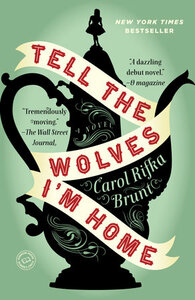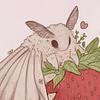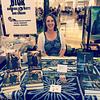Take a photo of a barcode or cover
Oh my goodness gracious, what an ending. And this is... a debut novel? Unbelievable.
The last 80% (or so) of the book was deeply engaging, I literally could not stop listening to it. As soon as a certain events transpires in the story, I couldn't stop and had to know how it ended. It has been so long since I've had that pull and magic from a story. It reignited my love for reading and listening (audio books are necessary in my lifestyle).
Brunt spins a wonderful tale of June, a lonely girl whose whole world dies in the form of her uncle, Finn. From there, Brunt tells the hardships of grief not only with June herself, but those around her. From her sister to this mysterious man she meets, June learns about the world around her and the wolves that appear in our lives. It's only the third week in January 2020, and I can already tell you that this will be a favorite read of mine FOR THE YEAR.
For reference, I didn't grow up during the introduction and scare of AIDs. I was born at the start of the 90's and was too young to comprehend the death of Freddie Mercury and the impact of AIDs. I am grateful to stories that educate me as they entertain me. Reading the book through June's eyes, I began to comprehend the fear of AIDs and the impact that it had on families affected by it. For those in similar situations as me, this is a harsh introduction to how individuals with AIDs were treated and a way to face the harsh reality that many underwent during the 80's and early 90's (and even today).
The last 80% (or so) of the book was deeply engaging, I literally could not stop listening to it. As soon as a certain events transpires in the story, I couldn't stop and had to know how it ended. It has been so long since I've had that pull and magic from a story. It reignited my love for reading and listening (audio books are necessary in my lifestyle).
Brunt spins a wonderful tale of June, a lonely girl whose whole world dies in the form of her uncle, Finn. From there, Brunt tells the hardships of grief not only with June herself, but those around her. From her sister to this mysterious man she meets, June learns about the world around her and the wolves that appear in our lives. It's only the third week in January 2020, and I can already tell you that this will be a favorite read of mine FOR THE YEAR.
For reference, I didn't grow up during the introduction and scare of AIDs. I was born at the start of the 90's and was too young to comprehend the death of Freddie Mercury and the impact of AIDs. I am grateful to stories that educate me as they entertain me. Reading the book through June's eyes, I began to comprehend the fear of AIDs and the impact that it had on families affected by it. For those in similar situations as me, this is a harsh introduction to how individuals with AIDs were treated and a way to face the harsh reality that many underwent during the 80's and early 90's (and even today).
I really enjoyed this book. It was beautifully written and poignant. I had such a difficult time putting it down.
Great read and different take on the coming-of-age novel, the 80s, and AIDS.
emotional
sad
slow-paced
Plot or Character Driven:
Character
Strong character development:
Yes
Loveable characters:
Complicated
Diverse cast of characters:
No
Flaws of characters a main focus:
Yes
Sinceramente no esperaba mucho de este libro pero me dejó sin palabras cuando lo terminé, tengo que admitir que lloré mucho durante la lectura porque me encariñé demasiado con los personajes y pude sentir el dolor de nuestra protagonista de su duelo y de la relación con su hermana y eso hizo que me golpeara más fuerte. Muy recomendable en mi opinión
A very well-balanced and excellently paced novel—the kind of thing my substantive book editing class has led me to view as technically perfect—though I wasn't spellbound. Still, the book is insightful and moving—very much worth a read.
The author takes the pre-medical breakthrough AIDS virus of the late 80's and made it intensely personal in a way that I, who lived through it as a high-schooler, didn't experience at the time.
June loves her Uncle Finn. She goes into New York City to visit him and they experience art and culture together. He's the only one who understands June--not her older sister Greta or her parents absent for most of the book because of tax season.
June likes to wear big black boots and read books about medieval art. She isn't the most popular girl at school. Because of her introversion, she's not the best at reading people, either.
So it comes as a surprise to her that her beloved uncle is dying.
I loved, loved how we get to experience one world at the beginning of the book through June's introverted POV, and then slowly, slowly experience another truth altogether by the end as June begins to learn about herself and the real reasons behind why her family acts the way they do.
It's a tricky balance to stay true to a character who grows and changes, and one this book pulls off splendidly. This is a book about love; all kinds of embarrassing, joyful, tricky, breathless love. It's also about making choices for the wrong reasons about who we want to be.
The relationship between June and her sister Greta was just a fascinating to watch unfold as the one between June and her uncle's "special friend." Both are tricky and layered, and you're never quite sure if June's narration of what's going in encompasses the whole truth.
The only small quibble I have is what seemed (to me, but maybe I'm misremembering the hysteria) the over-the-top reaction to the AIDs sufferers by the adults in the story. I found it a bit hard to swallow how the adults in the story acted (even policemen!).
But it's a small, small quibble.
This Book's Snack Rating: Dill Pickle Kettle Chips for the pervasive tart-salt relationships presented on solid, compulsively crunchable writing
June loves her Uncle Finn. She goes into New York City to visit him and they experience art and culture together. He's the only one who understands June--not her older sister Greta or her parents absent for most of the book because of tax season.
June likes to wear big black boots and read books about medieval art. She isn't the most popular girl at school. Because of her introversion, she's not the best at reading people, either.
So it comes as a surprise to her that her beloved uncle is dying.
I loved, loved how we get to experience one world at the beginning of the book through June's introverted POV, and then slowly, slowly experience another truth altogether by the end as June begins to learn about herself and the real reasons behind why her family acts the way they do.
It's a tricky balance to stay true to a character who grows and changes, and one this book pulls off splendidly. This is a book about love; all kinds of embarrassing, joyful, tricky, breathless love. It's also about making choices for the wrong reasons about who we want to be.
The relationship between June and her sister Greta was just a fascinating to watch unfold as the one between June and her uncle's "special friend." Both are tricky and layered, and you're never quite sure if June's narration of what's going in encompasses the whole truth.
The only small quibble I have is what seemed (to me, but maybe I'm misremembering the hysteria) the over-the-top reaction to the AIDs sufferers by the adults in the story. I found it a bit hard to swallow how the adults in the story acted (even policemen!).
But it's a small, small quibble.
This Book's Snack Rating: Dill Pickle Kettle Chips for the pervasive tart-salt relationships presented on solid, compulsively crunchable writing
Plot or Character Driven:
Character
Really really complex look into familial relationships and how the people you love and who love you make an imprint of your life. The idea that Toby and June spent so long loving Finn that they learned to love each other is put to such heartbreaking use in this story. And despite the focus in the blurb about June and Toby’s relationship, the parts that struck the truest to me were moments of June and Greta’s off-kilter relationship (echoed in their mother and Finn’s relationship). I think that was the true emotional core of the book.
I was just a bit put off by the fact that June is very much a teenager with teenager emotions that I do not share. It was hard to understand her motivations at times or the way she manifested her emotions.
I was just a bit put off by the fact that June is very much a teenager with teenager emotions that I do not share. It was hard to understand her motivations at times or the way she manifested her emotions.
Graphic: Death, Grief
Moderate: Homophobia
emotional
sad
medium-paced
Plot or Character Driven:
Character
Strong character development:
Yes
Loveable characters:
Yes
Diverse cast of characters:
N/A
Flaws of characters a main focus:
N/A
This book is a little challenging to review because it felt uneven to me — the ending was very strong and emotionally powerful, but at times in the middle I didn't have a lot of motivation to keep reading, or to pick it back up again. I liked the narrator, the character of June, a lot, but I also found her motivations and decisions hard to relate to sometimes. Still, I'm going to come down on the side of recommending it, because there's a lot that's done well.
The premise of the story is that the main character, who's fourteen, has a very close relationship with her uncle (so close that her sister mocks her for it). Her uncle, formerly a famous artist, paints a last portrait of the two sisters before dying of AIDS. Not only does the portrait become an important representation of June's family relationships (I won't say more than that), but June finds herself unwillingly drawn to the one person who loved her uncle as much as she did — his partner, Toby, whom her family has rejected, believing he maliciously gave her uncle AIDS.
The book is set in 1980s New York and, having read other books that hit you over the head with '80s nostalgia, I appreciated the subtler ways the author wove in the pop culture and current events of the time. Given the story she wanted to tell, the setting seemed entirely appropriate and well chosen.
Considering everything I liked and disliked about the book, I would say it's worth a read, especially if you like books about family relationships or about not fitting in, or you're just looking for a book that might make you cry.
The premise of the story is that the main character, who's fourteen, has a very close relationship with her uncle (so close that her sister mocks her for it). Her uncle, formerly a famous artist, paints a last portrait of the two sisters before dying of AIDS. Not only does the portrait become an important representation of June's family relationships (I won't say more than that), but June finds herself unwillingly drawn to the one person who loved her uncle as much as she did — his partner, Toby, whom her family has rejected, believing he maliciously gave her uncle AIDS.
The book is set in 1980s New York and, having read other books that hit you over the head with '80s nostalgia, I appreciated the subtler ways the author wove in the pop culture and current events of the time. Given the story she wanted to tell, the setting seemed entirely appropriate and well chosen.
Considering everything I liked and disliked about the book, I would say it's worth a read, especially if you like books about family relationships or about not fitting in, or you're just looking for a book that might make you cry.





